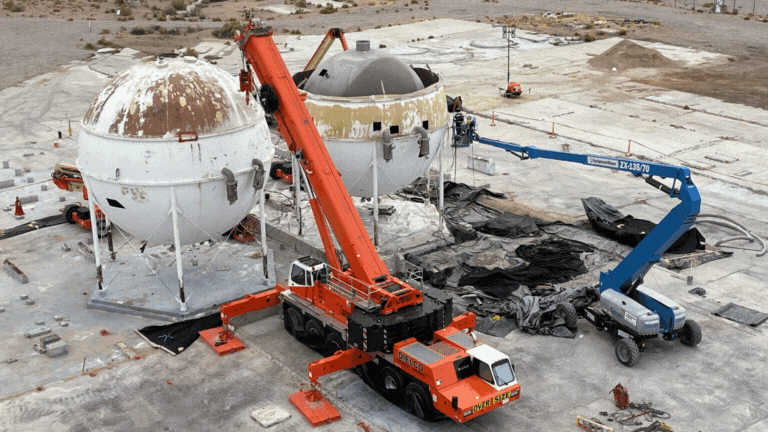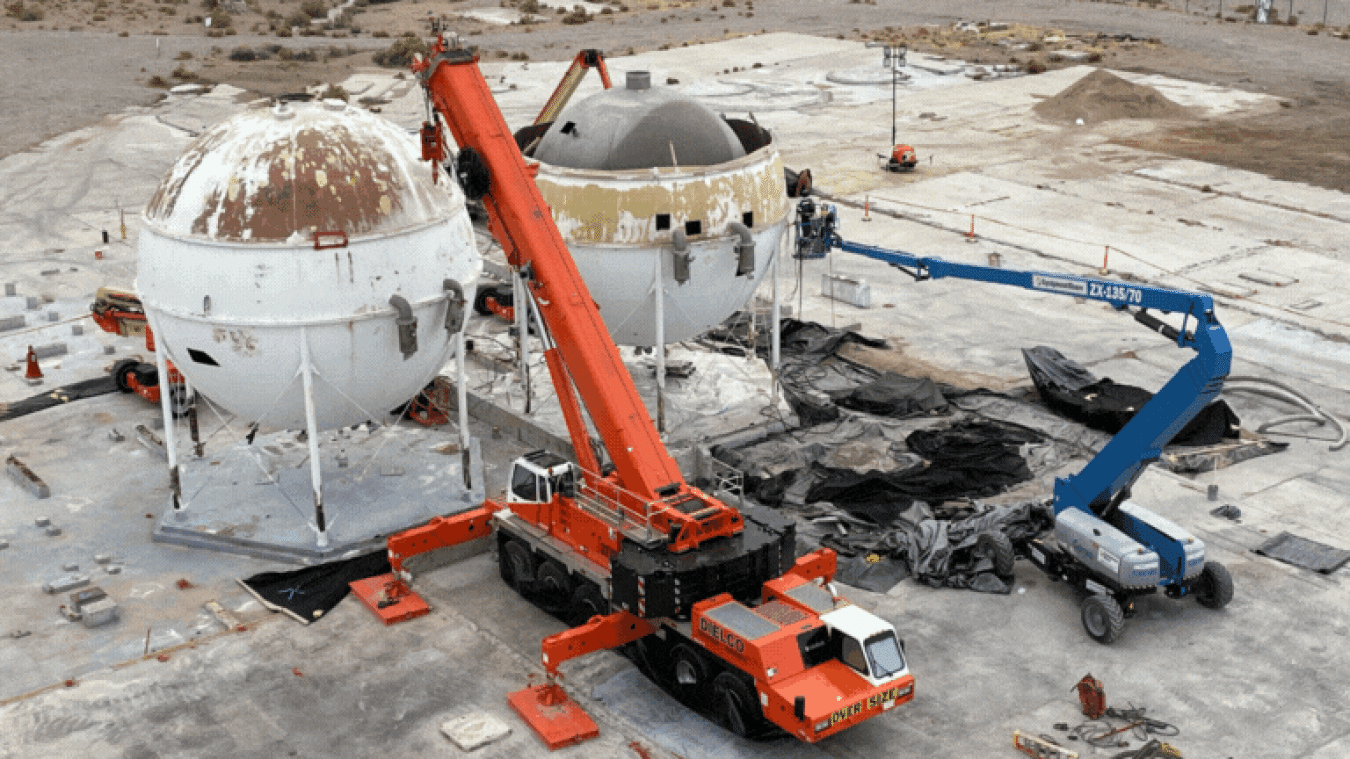Sept. 30, 2025 The Environmental Management Nevada Program has achieved a significant milestone with the successful demolition of a historic industrial structure at the Nevada National Security Site.
Office of Environmental Management
September 30, 2025Scenes from the takedown of the Test Cell C facility at the Nevada National Security Site. Environmental Management Nevada Program crews recently completed the demolition of the historic industrial structure.
LAS VEGAS — The Environmental Management (EM) Nevada Program has achieved a significant milestone with the successful demolition of a historic industrial structure at the Nevada National Security Site (NNSS).
U.S. Department of Energy (DOE) Office of Environmental Management crews dismantled the facility, Test Cell C (TCC), during three years of meticulous, labor-intensive work at Area 25 at the NNSS.
“By remediating TCC, we have reduced the EM footprint, furthered EM’s waste cleanup mission and met our obligations to Nevada residents by being strong stewards of the Silver State’s environment,” said Program Manager Robert Boehlecke. “We’ve done the work safely and we’ve met our environmental compliance milestones. We are all very proud of this work and it is great to see it come to a completion.”
Constructed in 1961, TCC was one of six major NNSS facilities that were part of the United States’ innovative efforts to develop nuclear-powered engines for rockets. Large, spherical tanks known as dewars at TCC held hundreds of thousands of gallons of liquid hydrogen used for ground testing of rocket engines.
EM Nevada contractor Navarro Research & Engineering began planning for the TCC demolition in 2022. Crews conducted biological surveys and took radiological samples throughout closure activities. They also removed electrical and lighting components known to contain regulated waste. Asbestos abatement was completed at all structures at TCC before demolition began.
Workers tore down a string of ancillary buildings at TCC using traditional demolition techniques. They used explosives to bring down a 150,000-gallon elevated water tank on a cold January morning in 2024.
Another challenge was removing insulation material, perlite, located between the inner and outer shells of the dewars. Crews carefully removed, packaged and disposed of about 500,000 pounds of the material prior to size-reduction activities of the dewars.
By far, the biggest challenge of the project was dismantling the dewars, said Navarro Construction Manager Jason Sofie. The largest of the globe-like structures were nearly four stories high and constructed using thick carbon and stainless steel. Watch a video about the dewars teardown here.
With unclear drawings from the 1960s, it took time to assess how thick the inner and outer sphere shells were and how the internal support system was arranged, Sofie said.
“All this drove a very unique cut plan to be able to safely and efficiently remove panels and segments of the outer and inner sphere shells,” Sofie said. “This was done without challenging the overall structural capabilities of the support systems within the vessel.”
Before and after: At left is a view of the Test Cell C facility at the Nevada National Security Site prior to demolition. At right is the concrete pad that remains following demolition of the historic industrial structure.
With safety in mind, Navarro and subcontractor Clauss Construction employed high-pressure, specialized water jets to make precise cuts as opposed to traditional torch-cutting methods. After the water jet cutting was complete, crews sectioned apart the dewars like an onion, and loaded and shipped the inner and outer shell segments for disposal.
“The team brought different experiences to the table and together, we adjusted and kept moving forward to complete the mission,” Sofie said.
Their successful completion of the TCC project is part of the broader story of how EM leverages the best of American industry to run the largest environmental cleanup program in the world, safely meeting DOE’s legal cleanup responsibilities to ensure American communities are safe and prosperous.
The EM Nevada team determined the stainless steel from the inner shells of the dewars was not contaminated and therefore could be recycled. The team worked with National Nuclear Security Administration contractor Mission Support & Test Services to recycle it.
“We ended up with close to 420,000 pounds of high-quality stainless steel available for recycling,” Sofie said.
With TCC demolished, the EM Nevada Program and Navarro have turned their attention to continued demolition work at the nearby Engine Maintenance, Assembly and Disassembly (EMAD) facility. EMAD is a much larger complex than TCC and was also part of the Nuclear Rocket Development Station.
Crews have already brought down a train shed and water tower at EMAD. The next phase of demolition will focus on the 100,000-square-foot main structure of EMAD.
“The EM Nevada Program is extremely proud of the work done to demolish and clean up Test Cell C,” Boehlecke said. “The project was carried out with safety of our workers the top priority from day one.”
-Contributors: Kevin Knapp, Glenn Puit
To receive the latest news and updates about the Office of Environmental Management, submit your e-mail address.




